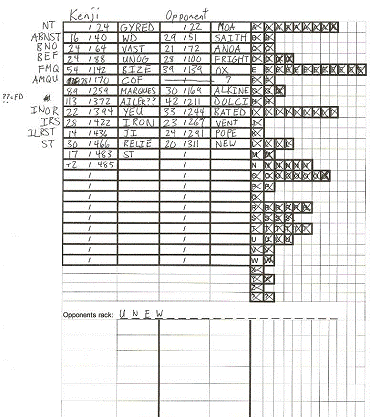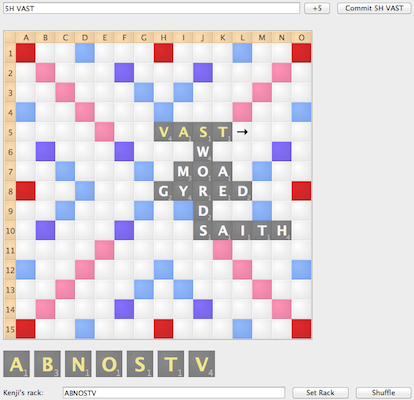(Note: This is the third installment on my series Breaking the Computer, analyzing the various uses and aspects of computers (particularly Quackle) and how they relate to Scrabble. For other articles in this series, please click here.)
One of the best features of Quackle is its ability to analyze your play in previous games. Computers allow a player to go through their games and find their mistakes, hopefully allowing them to play better in the future.
To use computer analysis, you must record your racks and the plays of both you and your opponent. Next, you need to input your game into Quackle. To input your rack, go to the bottom of the screen and erase the letters in the text box, and type in your rack, then click the “Set Rack” button. An example is shown below:
 |  |
Opponent’s Rack 3: Set rack to ABNOSTV. Then click at 5h, type VAST, click “Enter move”, then “Commit 8h VAST.”
Once you have input the game into Quackle, you can then evaluate your plays. To do this, double click on any of your plays and click on the “Generate Choices” button. A list of the best possible plays ranked by points and leave will appear, generated by a module called a kibitzer. Plays can also be added or removed from the kibitzer with ease. A more precise evaluation of plays can be performed by using a simulation. To perform a simulation, click the “Simulate” button to begin the simulation. Once you run the simulation for about a minute, the best play will gradually rise to the top. Using Quackle can help you identify your mistakes, so you can learn and make a better play next time.
Here is the important part: now you have to do something with this information. Many people use this information just to learn new words, but there is so much more that can be used with this information. In addition to some short term strategy, leave values, and positional understanding, you can also learn how to change your play over the board, which is the most important function of game analysis.
At this point, look for consistencies in the mistakes that you make. Some of them might be one-off brain farts, but over the course of your mistakes, patterns will emerge. Strong Scrabble players often find reviewing their previous games (and finding the errors) to be extremely useful. Once you have gone through a significant number of games and logged your errors, you can use this data to become a better player.
Step 1 is to catalog your errors, using a spreadsheet and listing your errors by game. Many players will find it more effective if this compilation is made by another player, as it can provide an objective view of your strengths and deficiencies. Make sure to note only severe errors, as minor errors are both subjective and are not useful for the purposes of improvement.
Step 2 is to sort this information by the type of error. Categories depend on the person, but common category errors include word knowledge, word security, board vision, rack vision, board control, leave evaluation, and others.
Step 3 is to focus on improving your skill set. The way to focus and improve on a specific skill is different for each player. These techniques are useful skills for improving in general, but are extremely useful if you want to concentrate on strengthening a specific skill set.
As an example, I present this analysis that I did on Will Anderson based on his games at the 2012 Nationals. (Will is a top American Scrabble player who has since fixed many of these errors, and played pronouncedly better at this year’s Nationals). I also present this analysis on Joshua Sokol-Rubenstein, based on these games. (Josh was rated in the 1600s before this)
